Nintendo 64 Mario games!

Nintendo 64 console!
Released: June 23, 1996
Nintendo 64 ( often abbreviated as N64) is Nintendo 's third home video game console for the international market. Named for its 64 bit processor , it was released on June 23 , 1996 in Japan , September 29 , 1996 in North America and Brazil , March 1 , 1997 in Europe and Australia , and September 1 , 1997 in France (the system also saw a release in Latin America , albeit an unofficial one).
It was released with three launch games in Japan ( Super Mario 64 , Pilotwings 64 and Saikyou Haniu Shogi ), and two in North America and PAL region ( Super Mario 64 and Pilotwings 64 ). The N64's suggested retail price was US$ 199 at its launch.
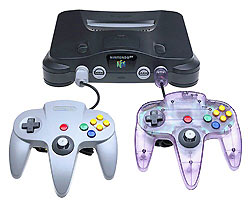
The Nintendo 64 was the last mainstream home video game console to use masked ROM cartridges to store its games (although the last real cartridge based system to have still continued production was SNK 's Neo Geo hardware until 2004 ).
Nintendo cited several advantages for making the N64 cartridge-based:
- ROM cartridges have very fast load times in comparison to disc based games, as contemporary CD-ROM drives rarely had speeds above 4x. This can be observed from the loading screens that appear in many Sony PlayStation games but are typically non-existent in N64 versions. ROM carts are so much faster than the 2x CD-ROM drives in other consoles that developers could stream data in real-time off them. This was done in Indiana Jones and the Infernal Machine , for example, to make the most of the limited RAM in N64. One could describe the ROM as an additional amount of slow RAM, similar to virtual memory in a modern operating system.
- ROM cartridges are difficult and expensive to duplicate, thus resisting piracy, albeit at the expense of lowered profit margin for Nintendo. (Nintendo had likely weighed the tradeoffs and concluded that reducing losses from piracy would offset higher cartridge production costs.) While unauthorized interface devices for the PC were later developed, these devices are rare when compared to a regular CD drive as used on the PlayStation. Compared to the N64, piracy was rampant on the PlayStation and Playstation 2.
- It is possible to add specialized support chips (such as coprocessors) to ROM cartridges, as was done on some SNES games (notably Star Fox , using the Super FX chip).
- Most cartridges store individual profiles and game progress on the cartridge itself, eliminating the need for separate and expensive memory cards . Storing data at first required a cartridge battery whose energy would diminish over time, though the battery generally lasted for years, and in subsequent games EEPROMs were used instead.
- ROM cartridges are far more durable than CD-ROMs. It is extremely difficult to damage a cartridge, whereas compact discs must be carefully used and protected in cases. This makes the cartridges better for children who do not know how to take care of CD-ROMs. It also prevents accidental scratches even by adult owners, and subsequent read errors from these inevitabilities.
- It was also a frequent occurrence for the mechanisms of early CD-ROM drives to fail. There are no moving parts with a ROM cartridge system.
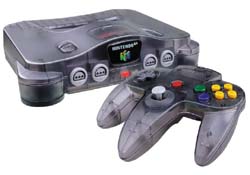
Disadvantages
- While game cartridges are more resistant than CDs or DVDs to mechanical damage, they are sometimes less resistant to long-term environmental damage, particularly oxidation or wear of their electrical contacts. (The cartridges for Nintendo's earlier NES system were particularly notorious for this)
- Console cartridges are usually larger than optical discs and hence need more storage space.
- Cartridges can store significantly less data than DVDs or CDs - some games ported from other media had to use data compression or reduced content in order to be released on the N64.
- More complex manufacturing processes meant games were usually more expensive than their Optical counterparts.
- Because of a cartridge's space limitations, full motion video was not feasible (as on CDs) for use in cutscenes.
Graphics
Graphically, results of the Nintendo cartridge system were mixed. The N64's graphics chip was capable of trilinear filtering , which allowed textures to look very smooth compared to the Sega Saturn and the Sony PlayStation; neither could provide better than nearest neighbor interpolation , resulting in textures that were highly pixelated . However, the limited storage size of ROM cartridges limited the amount of available textures, resulting in games which had blurry graphics because of the liberal use of stretched, low-resolution textures, which was compounded by the N64's 4096-byte limit on a single texture. Some games, such as Super Mario 64 , use a large amount of Gouraud shading or very simple textures to produce a cartoon-like look. This fit the themes of many games, and allowed this style of imagery a sharp look while hiding the texturing limitations of the machine.
Later cartridges such as Resident Evil 2 featured more ROM space, which demonstrated that N64 was capable of detailed in-game graphics when the media permitted.
- N64 Controller - an 'm'-shaped controller with 10 buttons (A, B, C-Up, C-Down, C-Left, C-Right, L, R, Z and Start), one analog stick in the center, a digital directional pad on the left hand side, and an extension port on the bottom. Initially available in six colors (gray, yellow, green, red, blue and black) and later in transparent version of such colors (except gray). The N64 pad's analogue stick is notorious for becoming very worn, and difficult to manipulate accurately. Also, the analog stick had to be centered properly when the system was booted up; if the stick was aimed in the wrong direction, which would be set as the default for the game, causing, for example, Mario to march off in the wrong direction without being told to do so. There are various (some quite dubious) 'DIY' ways of mending a worn-out N64 analogue stick. The problem pads are actually only from the earlier part of the N64's life-cycle, as Nintendo introduced a newer model to address the issue. While not greatly publicized, and visually identical, the redesigned pads eliminated the premature wear-and-tear problem with the analogue sticks.
- Controller Pak - a memory card that plugged into the controller and allowed the player to save game progress and configuration. The original models from Nintendo offered 256 KB Flash RAM , split into 123 pages, but third party models had much more, often in the form of compressed memory. The number of pages that a game occupied varied. A Controller Pak was initially useful or even necessary for the earlier N64 games. Over time, the Controller Pak lost ground to the convenience of a back-up battery (or flash memory) found in some cartridges. Games by Konami often required the Controller Pak for saves, even though the games could have easily contained three or more save-slots (such as in the case of Holy Magic Century )
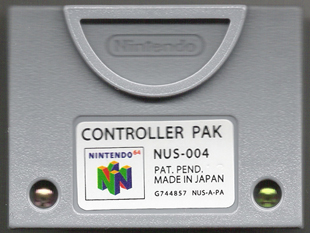
- Expansion Pak - a memory expansion that plugged into the console's memory expansion port. It contained 4 MiB of RAM . Some of the games to support this accessory are Turok 2 , Hybrid Heaven , Pokémon Stadium 2 , Shadow Man , Star Wars: Episode I Racer , Rare's Perfect Dark , Midway's San Francisco Rush 2049 , and only a handful of games such as Donkey Kong 64 , the single-player mode of Perfect Dark and The Legend of Zelda: Majora's Mask actually required it for play. Supporting games usually offered higher video resolutions or higher textures and/or higher color depth. For example, the Nintendo 64 all-remade version of Quake 2 features higher color depth but not a higher resolution when using the Expansion Pak. The Expansion Pak was shipped with some games and also available separately.
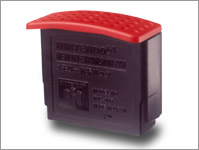
- Rumble Pak - an accessory that plugged into the controller and vibrated during game play. It has (since its release in 1997 alongside Star Fox 64 ) become a built-in standard for the current generation console controllers, with the exception of the Playstation 3, which, due to lawsuits, was left out of the controller.
- Transfer Pak - an accessory that plugged into the controller and allowed the Nintendo 64 to transfer data between Game Boy and N64 games. Pokémon Stadium and Pokémon Stadium 2 are games that rely heavily on the Transfer Pak. Both versions of Mario Golf & Mario Tennis used it too. Rare's Perfect Dark was initially going to be compatible with the Transfer Pak in order to use pictures taken with the Game Boy Camera in the game but this function was scrapped, and the Transfer Pack was usable only in combination with the Game Boy Color version of Perfect Dark for unlocking bonuses.
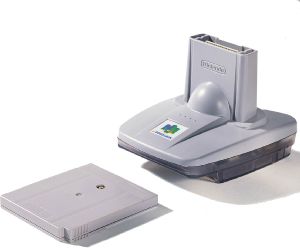
- The Wide-Boy 64 an adapter similar to the Super Game Boy and was able to play Game Boy games; however, it was only released to the developers and the press. Third party adapters allowed regular consumers to do the same.
- 64DD - The official N64 Disk Drive attachment was a commercial failure and was consequently never released outside of Japan. It featured networking capabilities similar to the SNES Satellaview.
- VRU (Voice Recognition Unit) - this device is packed in and required to play Hey You, Pikachu! . It consisted of a ballast that connects into controller port 4 of the system, a microphone , a yellow cover for the microphone and a clip for clipping the microphone to the controller. Players would hold the R or Z button on the controller and talk to Pikachu . One major drawback is the fact that the VRU is only calibrated to high pitched voices like that of a child as stated in the manual, so an older child will have problems issuing commands. However, most males can use their falsetto to talk in a higher voice.
- Dance Pad (Japan Only) - A dance pad packaged with Dance Dance Revolution: Disney Dancing Museum.
Third party accessories
- Game Shark - A cheat device made by Interact. Two versions were made. The first version had a LED display that would count down 5 seconds upon turning the system on. The period in the display would be lit while playing to show that the unit was functioning. There is a slot on the back of the unit for an expansion card that was never made. The second version (Known as the 'Pro' series, versions 3.2 and up) had a SCSI or parallel port on the back for connecting to a computer for downloads. It also featured a cheat search function as well as being able to find the name of the game for you. It also had a LCD display that counted down 5 seconds when started and the period in the display would be lit while playing to show that the unit was functioning. This feature was removed in version 3.3.
- Sharkwire Online Keyboard - An Interact device that adds a modem and PC style keyboard to the Nintendo 64 with expansion pack. Allowed emailing and Game Shark updates through the now discontinued sharkwire.com dial-in service.
- GB Hunter - Like the Super Game Boy, connects to the N64's Cartridge slot and allows you to play Game Boy and Game Boy Color games on it.
- Dex Drive - Made by Interact, allowed you to upload data from your memory cards and either store the files on your computer, or send via the internet.
- High Rez Pack - Mad Catz own version of the Expansion Pak. Performs the same job for less money, though there were reports of overheating due to inadequate cooling/venting, and generally inferior quality.
- Bio Sensor - An ear-clip that plugs into the Controller Pak slot of the N64 controller to measure the user's heart rate . Released only in Japan and compatible only with Tetris 64 where it will slow down or speed up the game depending on how fast the player's heart is beating.
- Battery free Rumble Paks (3rd party) - late in the N64's run, a few 3rd party companies made rumble paks that worked without batteries but instead drew their power from the system.

